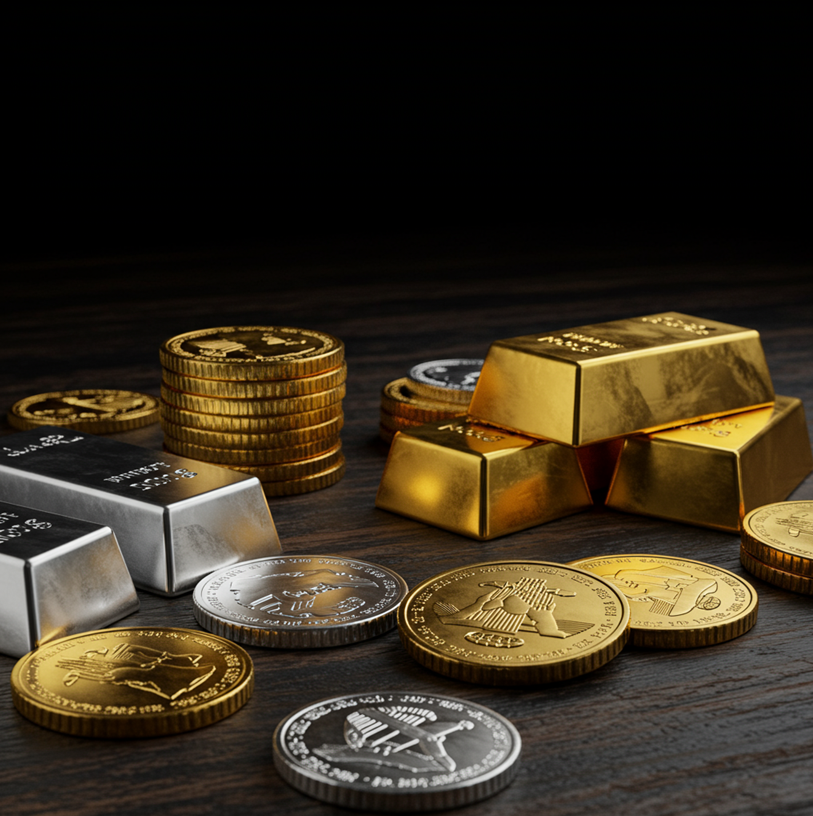Gold has captured headlines again, soaring past $3,200 per ounce and touching $3,500 in April—a dramatic climb from under $2,400 just one year ago and under $2,000 two years back. While the financial media buzzes with predictions of continued growth, it is important to filter out the noise and intentionally decide what role precious metals have in your wealth-building strategy.
My relationship with gold and silver is a little more complicated and a lot less reactive.
Reframing Gold: Store of Value, Not Investment Vehicle
Gold is not an investment in the traditional sense. Unlike real estate that you can improve to force appreciation, businesses that build customer bases to increase profits, or bonds or rental properties that generate monthly cash flow, gold produces no income. It sits there, holding its intrinsic value while generating no profit. Speculating on short-term price movements or investing in volatile mining companies resembles gambling more than investing.
However, gold serves a different but equally important purpose: as a long-term store of value. For millennia, civilizations have recognized gold and silver as reliable representations of wealth. As one of my mentors frequently reminds me, “An ounce of gold is worth an ounce of gold.” This simple truth reveals gold’s remarkable consistency over time.
Consider this perspective: an ounce of gold could purchase a quality men’s suit in the 1950s, and remarkably, it still can today. This purchasing power stability extends to larger purchases as well. In 1950, gold traded at approximately $40 per ounce while the average house cost $7,350—requiring about 184 ounces of gold. Fast forward to 2024, with houses averaging $417,000 and gold starting the year at $2,100 per ounce, you would need 198 ounces for that same purchase. Despite 75 years of economic changes, gold’s purchasing power remained remarkably stable relative to real estate values.
Of course, with the prices of both houses and gold fluctuating over time, that correlation is not perfect at every point in time. At current gold prices of $3,300, that same average house would cost only 127 ounces—suggesting either gold is overvalued or housing is undervalued relative to historical norms.
Understanding the Price Drivers: Inflation and Supply and Demand
Since gold maintains its inherent value, what drives these dramatic price swings? Two primary factors explain the volatility.
First, we measure gold prices in currencies that steadily lose purchasing power through inflation. The dollar today holds significantly less value than a dollar from previous decades—in fact, the dollar has lost 97% of its value since 1900 [1]. If inflation were the only factor affecting gold prices, that $40 ounce from 1950 would cost over $530 today simply to maintain equivalent purchasing power.
Second, supply and demand dynamics create price volatility. Annual gold production remains limited to under 5,000 tonnes globally, but demand fluctuates dramatically across three major categories [2]. Jewelry continues driving the largest demand segment, accounting for approximately 1,800 tonnes or 44% of 2024 consumption. This represents centuries of consistent cultural demand for gold. Investment demand through vehicles like gold ETFs has surged over 1,100 tonnes, representing a 25% year-over-year increase. This speculative buying likely drives much of the recent dramatic price appreciation. More intriguingly, central banks worldwide have dramatically increased their gold purchases since 2022, acquiring over 1,000 tonnes annually with 2022 setting records [3]. This institutional buying represents a significant shift in monetary policy thinking and contributes to current price pressures.
Following the Central Banks
While it is easy to dismiss investment speculation as typical market behavior chasing the current hot asset, the central bank buying trend deserves attention. These institutions operate with different time horizons and motivations than individual investors. Central banks use gold reserves to back their currencies and provide stability during uncertain times. When countries worry about their currency losing purchasing power, gold offers protection that maintains value independent of currency (since no single government backs it). This differs from holding US Treasuries, for example, which hedge against currency devaluation relative to the dollar but remain tied to US government stability.
The coordinated increase in central bank gold reserves suggests these institutions expect sustained high inflation for extended periods. While economists debate the duration and severity, this institutional behavior provides valuable insight. Rather than betting on interest rates and inflation declining quickly—as many hope—consider positioning your portfolio to perform well even if rates and inflation remain elevated compared to the past two decades. This shift in baseline assumptions could significantly impact investment returns across asset classes.
An alternative hypothesis for why banks are buying gold is that the US will lose its reserve currency status and gold provides a reliable alternative if the USD is no longer stable. If this is the actual driver, it seems likely that this will take decades to occur since there is currently no reasonable alternative. While the BRICS [4] are trying to accelerate this transition, that effort has been going on since at least 2009 and still appears to be in its infancy. Without a strong contender to replace it, the USD seems secure as the reserve currency for now.
Gold’s Role in An Investment Thesis
How should gold fit into a portfolio focused on building passive income streams? I believe the answer lies in understanding its role as a value store rather than its profit potential.
Most of your wealth should work actively for you. As long as your investments outpace inflation while generating cash flow, you benefit more from productive assets than from holding gold. Real estate investments, dividend-paying stocks, and business ownership should comprise your portfolio’s foundation.
However, gold serves as excellent insurance for funds intended for distant future use. Instead of parking long-term money in savings accounts earning minimal interest, allocating a small percentage to precious metals provides an inflation hedge that maintains purchasing power indefinitely.
This approach offers flexibility: sell the metal when you need currency for spending, or hold it indefinitely as value preservation. The strategy fails only if you expect complete financial system collapse requiring a return to gold-as-currency—a scenario that seems unlikely in the foreseeable future.
In addition, gold and silver offer an interesting practical application beyond traditional investment strategies. Instead of giving gift cards or items that lose relevance over time, consider precious metal coins for significant life events like graduations. These gifts combine sentimental value with practical worth that appreciates over time, creating lasting meaning while preserving purchasing power.
Looking Forward
Central bank buying seems likely to continue as currency debasement concerns persist globally. Investment demand may fluctuate with market sentiment, but jewelry demand provides a stable baseline. Meanwhile, mining supply constraints limit how quickly production can respond to higher prices. As a result, I expect there to be high volatility in the short term with prices to continue to rise over the long term.
Based on this thesis, I limit precious metals to a small percentage of my total net worth—enough to provide inflation protection without reducing my productive asset allocation. In other words, I use gold strategically for very long-term wealth preservation, particularly for funds I might not access for decades. Instead, I focus the majority of my portfolio on cash-flowing real estate, business investments, and traditional securities that generate returns above inflation.
For additional reading:
- https://www.officialdata.org/us/inflation/1900?amount=1
- https://www.owmarkets.com/market-analysis/71/world-gold-council-report-explained-gold-demand-overview-in-2024
- https://investingnews.com/daily/resource-investing/precious-metals-investing/gold-investing/top-central-bank-gold-holdings/
- https://brics.br/en
This article is my opinion only, it is not legal, tax, or financial advice. Always do your own research and due diligence. Always consult your lawyer for legal advice, CPA for tax advice, and financial advisor for financial advice.


